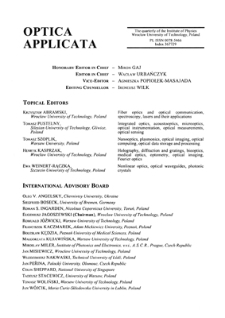Obiekt
Tytuł: AFM examination of sol–gel matrices doped with photosensitizers
Autor:
Wysocka, Katarzyna ; Ulatowska-Jarża, Agnieszka ; Bauer, Joanna ; Hołowacz, Iwona ; Savu, Bogdan ; Stanciu, George ; Podbielska, Halina
Współtwórca:
Gaj, Miron. Redakcja ; Urbańczyk, Wacław. Redakcja
Opis:
Optica Applicata, Vol. 38, 2008, nr 1, s. 127-136
Abstrakt:
Wydawca:
Oficyna Wydawnicza Politechniki Wrocławskiej
Miejsce wydania:
Data wydania:
Typ zasobu:
Identyfikator zasobu:
Źródło:
<sygn. PWr A3481II> ; kliknij tutaj, żeby przejść ; kliknij tutaj, żeby przejść
Język:
Powiązania:
Optica Applicata ; Optica Applicata, Vol. 38, 2008 ; Optica Applicata, Vol. 38, 2008, nr 1 ; Politechnika Wrocławska. Wydział Podstawowych Problemów Techniki
Prawa:
Wszystkie prawa zastrzeżone (Copyright)
Prawa dostępu:
Dla wszystkich w zakresie dozwolonego użytku
Lokalizacja oryginału:
Tytuł publikacji grupowej:
Kolekcje, do których przypisany jest obiekt:
- Dolnośląska Biblioteka Cyfrowa > Uczestnicy Konsorcjum > 01. Politechnika Wrocławska > Czasopisma > Wydane w PWr > Optica Applicata
- Dolnośląska Biblioteka Cyfrowa > Zasoby > 2. Czasopisma > Czasopisma współczesne
- Dolnośląska Biblioteka Cyfrowa > Dziedziny nauki > 6. Nauki ścisłe i przyrodnicze
Data ostatniej modyfikacji:
21 mar 2019
Data dodania obiektu:
21 mar 2019
Liczba wyświetleń treści obiektu:
58
Wszystkie dostępne wersje tego obiektu:
https://dbc.wroc.pl./publication/113959
Wyświetl opis w formacie RDF:
Wyświetl opis w formacie OAI-PMH:
| Nazwa wydania | Data |
|---|---|
| AFM examination of sol–gel matrices doped with photosensitizers | 21 mar 2019 |
Podobne
Hołowacz, Iwona Ulatowska-Jarża, Agnieszka Wysocka, Katarzyna Głuchowski, Paweł Stręk, Wiesław Podbielska, Halina Gaj, Miron. Redakcja Urbańczyk, Wacław. Redakcja
Hołowacz, Iwona Podbielska, Halina Bauer, Joanna Ulatowska-Jarża, Agnieszka Gaj, Miron. Redakcja Wilk, Ireneusz. Redakcja
Ulatowska-Jarża, Agnieszka Hołowacz, Iwona Wysocka, Katarzyna Podbielska, Halina Gaj, Miron. Redakcja Urbańczyk, Wacław. Redakcja
Ulatowska-Jarża, Agnieszka Podbielska, Halina Gaj, Miron. Redakcja Wilk, Ireneusz. Redakcja
Andrzejewski, Damian Podbielska, Halina Ulatowska-Jarża, Agnieszka Gaj, Kazimierz. Redakcja Wilk, Ireneusz. Redakcja
Jeleń, Łukasz Cegielski, Marek Ulatowska-Jarża, Agnieszka Podbielska, Halina Gaj, Miron. Redakcja Wilk, Ireneusz. Redakcja
Ulatowska-Jarża, Agnieszka Lechna-Marczyńska, Monika Podbielska, Halina Gaj, Kazimierz. Redakcja Wilk, Ireneusz. Redakcja
Bauer, Joanna Ulatowska-Jarża, Agnieszka Podbielska, Halina Lechna-Marczyńska, Monika Bindig, Uwe Müller, Gerhard Beuthan, Jürgen Gaj, Miron. Redakcja Wilk, Ireneusz. Redakcja
























